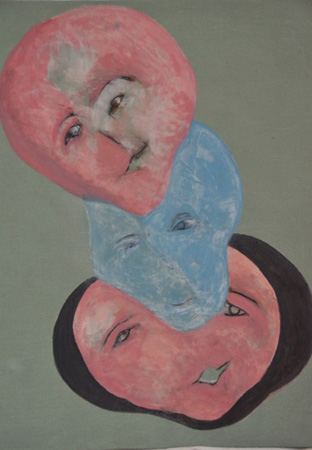Basil King: Mirage
patrick brennan
April 2015
<
Not everything can go into One painting one poem
Not everything can go into One painting one poem
Basil King
Among context invoking in-betweens such as essays, interviews, reviews and descriptions, it’s not that often that an artist can be so influentially positioned to shape these as in Nicole Peyrafitte’s and Miles Joris-Peyrafitte’s deft 23 minute short film, Basil King: Mirage, which ably affords this occasion to painter and poet Basil King.
Born in London in 1935, King witnessed the blitz and then some before his parents relocated the family to Detroit in 1947. Struck already by Pollock and Rimbaud, he was walking past the Detroit Art Institute’s Rivera murals for studio classes and, by 16, had arrived at Black Mountain College to learn from Charles Olson and Esteban Vincente, segueing afterwards to San Francisco and its poets, then to New York City and Gottlieb, Motherwell, Rothko, Kline, Amiri Baraka and Frank O’Hara while hearing Miles, Monk and Coltrane during these key moments of high artistic intensity in the United States. While all of that was happening, Basil King was there.
King’s poetic presence is every bit as penetrating as his painting; and the film stretches across excerpts from his long poem, Mirage — all at once autobiography, saga, song and affirmation, read in his Brooklyn studio in the painter’s own richly centered vocal tones, informing and revealing in ways that conventional interview and critical assessment can only infrequently hint at.
The documentary alternates shots of the artist reading, writing and painting, a cameo appearance by his wife — the poet Martha Winston King, family photos and such with generous views of his paintings. They’re immediately arresting like astonishing glimpses. Yet these glimpses sustain to unravel an interior complexity and mystery that’s not at all lacking in staying power.
For an artist of this generation, King’s work is refreshingly exempt of the scisms of Ismism. It resists settling for such preemptive categories, curving more inclusive and contradictory than reductive, not only in relation with what one lives, but with the whole of our visual art inheritance.
A viewer very often witnesses figures and faces here, but untethered to the literal correspondences often glibly accepted as “realism.” In King’s own words, “From the abstract to the figure, from the figure to the abstract makes an edge of exquisite distance and distance gives us our sensations.”
Topographical specificity retains direct personal experience within the perceptual field here, engaging more than the data of what one sees (and/or preconceptualizes), but inseparably how one feels into vision. His paintings exude an under-the-skin tactility and expose the tender and complicated whispered intimacies of what it feels like to exist, here accepted and revealed without apology.
King’s been adept at poker. He once cleaned out a group of wallstreeters, which helped him buy his family a house decades ago when such things were still accessible. And he continues to gamble, taking risks in his poems, in his paintings and with his life, this notably marked more than once in this film by his invoking a somewhat unfashionable condition and practice: devotion. King has staked his life and work on the long haul during an era where the quick kill has become more often celebrated.
Nicole Peyrafitte’s multidisciplinary repertoire can’t have helped but inform the wry sensitivity with which she’s molded this project along with her co-director Miles Joiris-Peyrafitte, whose attentive camera work further enriches this collaboration.
Basil King: Mirage is being screened every half hour in the Lecture Room at the Walker Art Center, Minneapolis from 5-9pm on Thursday, April 9th, 2015 as part of its Rain Taxi 20th Anniversary Bash, and is currently available for schools, art centers, galleries, or libraries. Updates and news about future viewings may be found at basilkingmirage.net.

Pendular B mixed media on canvas 22″ x 26″ 2013
View the Venus’ back and she looks as if she has both arms. A three-quarter view and only her right arm is missing above the elbow. I can’t stop thinking there is something deliberate that part of both arms are missing. Were they deliberately cut off to make her figure more attractive, alluring.
PAUSE
Open up a magazine, pages of young men and women (mostly women) advertising hand bags, underwear and designer clothes pose in alluring often vulnerable positions. Today it is the opposite of the Greek formula, the models pretend to be statues. Are we being manipulated again? I tread lightly but I think the Greeks asked us to see statues as people, they insisted that only beautiful people are entitled only beautiful people are worthy of recognition.
Reality/Fantasy
What comes first
fantasy or reality
measure the distance the need
to draw and paint
the need to recognize something
this is not youI paint and I draw and I
follow in the footsteps of all the painters
that came before mefantasy/reality
the imagination and the abstract rock
excerpt from The Spoken Word / the Painted Hand from Learning to Draw A History by Basil King, Marsh Hawk Press, 2014

yeah
This Work Needs to be seen!
The writing can be read and
Gotten BUT
The paintings and drawings are vital to how we come to be in this world and how to see it with clarity!
Basil King learns to draw
And in the process he teaches us how to see!